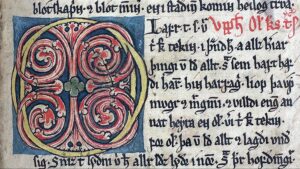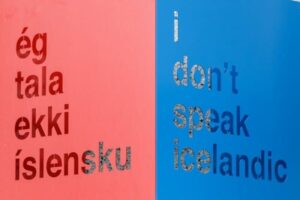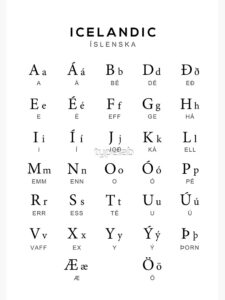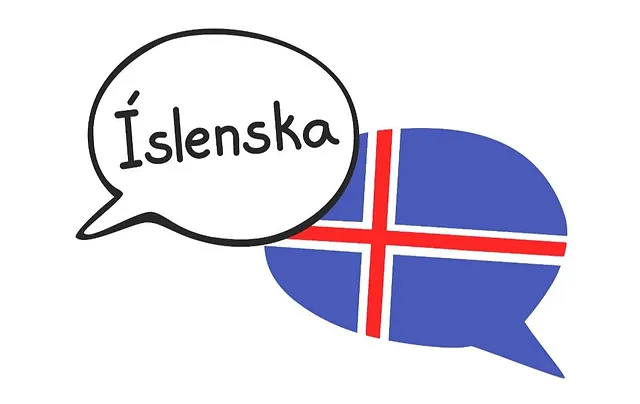Icelandic, the language of Vikings and sagas, stands as a testament to the preservation of Old Norse in modern times. Its evolution, intricately intertwined with the history and culture of Iceland, showcases a fascinating journey of linguistic continuity and adaptation. From the ancient manuscripts of medieval Iceland to its status as a vibrant living language today, Icelandic serves as a remarkable example of how a language can maintain its roots while embracing change. This article explores the evolution of Icelandic, highlighting its unique features and the ongoing efforts to preserve its rich heritage.
Historical Roots

At the heart of Icelandic lies Old Norse, the language spoken by the Norse settlers who colonized Iceland in the 9th century. These early settlers brought with them a rich oral tradition, including myths, legends, and epic poetry, which would later be recorded in written form. The Icelandic sagas, written between the 12th and 14th centuries, provide invaluable insights into the language and culture of medieval Iceland. Despite the passage of time, many words and expressions from Old Norse remain remarkably intact in modern Icelandic, reflecting a deep sense of linguistic continuity.
The isolation of Iceland played a crucial role in preserving the purity of the Icelandic language. Cut off from mainland Europe, Icelanders developed their own distinct dialect, largely unaffected by outside influences. This isolation, coupled with a strong literary tradition, helped to safeguard Icelandic against significant changes over the centuries. As a result, modern Icelandic retains much of the grammatical structure and vocabulary of its medieval counterpart, making it one of the closest living relatives of Old Norse. If you want to see old Icelandic historical books in the Belgrade museum, get a car from the rent a car Belgrade company and drive to it.
Icelandic historical roots are not just a matter of linguistic curiosity; they are deeply intertwined with the cultural identity of the Icelandic people. The sagas, in particular, hold a special place in Icelandic literature, serving as a source of national pride and inspiration. By preserving the language of the sagas, Icelanders maintain a direct connection to their ancestors and the rich tapestry of their shared history. In this sense, Icelandic is more than just a means of communication; it is a living link to the past, a repository of centuries of tradition and heritage.
Linguistic Characteristics
One of the most striking features of Icelandic is its conservative grammar and syntax. Unlike many other Germanic languages, Icelandic has retained a highly inflected morphology, with four cases, two numbers, and strong and weak noun declensions. Verbs conjugate according to tense, mood, voice, person, and number, adding layers of complexity to the language. This intricate system of inflection allows for precise expression and lends Icelandic its distinctive flavor.
Just as linguistic evolution ensures the legacy of Old Norse lives on, men’s patriotic t-shirts serve as wearable symbols, preserving and conveying cultural pride in a visually compelling manner.
The preservation of archaic features sets Icelandic apart from its Scandinavian counterparts. For example, Icelandic maintains the use of the runic letter “Þ” (thorn), representing the voiceless dental fricative, which has disappeared from most other Germanic languages. Similarly, the distinction between the nominative and accusative cases in masculine and feminine nouns harkens back to Old Norse grammar. These vestiges of the past serve as reminders of Icelandic’s rich linguistic heritage.
Beyond its grammatical intricacies, Icelandic is known for its poetic sensibility and expressive vocabulary. The language abounds with imagery, metaphor, and alliteration, making it well-suited to the oral tradition from which it emerged. The poetic heritage of Old Norse lives on in modern Icelandic poetry, which continues to explore themes of nature, mythology, and the human experience. In this way, Icelandic serves not only as a means of communication but also as a medium for artistic expression and cultural identity.
Similar to the preservation of Old Norse in modern linguistics, where ancient roots persist within a contemporary framework, the best spa in Toronto intertwines traditional wellness practices with modern amenities.
Modern Challenges
While Icelandic has managed to endure for over a millennium, it faces several challenges in the modern era. Globalization, advances in technology, and increased contact with the outside world have led to the influx of foreign words and expressions into Icelandic. English, in particular, exerts a significant influence on Icelandic vocabulary, especially in domains such as technology, commerce, and popular culture.
Much like the dynamic changes a language undergoes over time, the evolution of health services in Dallas, TX reflects an ongoing adaptation to the needs of a growing and diverse population.
The impact of these external influences has sparked debates about the future of Icelandic and the need to balance preservation with adaptation. Some linguists advocate for the purist approach, emphasizing the importance of maintaining Icelandic’s purity and integrity. Others argue for a more pragmatic approach, acknowledging the inevitability of language change and advocating for the incorporation of loanwords where necessary. Finding a delicate balance between these competing priorities remains an ongoing challenge for Icelandic language planners.
Researching Icelandic linguistic history and culture is even more captivating while eating the sweetest milk chocolate edibles.
In addition to external influences, demographic shifts within Iceland pose challenges to the preservation of Icelandic. The influx of immigrants and the growing prevalence of English as a second language among Icelanders raise questions about the long-term viability of Icelandic as the primary means of communication. Efforts to promote Icelandic language education and encourage linguistic diversity within Iceland’s multicultural society are essential for ensuring the continued vitality of the language.
Preserving the Legacy

Despite these challenges, efforts to preserve Icelandic as a distinct linguistic heritage continue unabated. The Icelandic government has implemented various measures to promote the use of Icelandic in education, media, and public life. Language revitalization programs aim to instill pride in Icelandic identity and encourage linguistic proficiency among Icelanders of all ages. Additionally, organizations such as the Árni Magnússon Institute for Icelandic Studies are dedicated to the study and preservation of Icelandic language and culture.
Much like the meticulous efforts to maintain the essence of Old Norse in Icelandic, Cheyanne Mallas embodies the spirit of preserving diverse skills and knowledge, blending entrepreneurship with a medical profession.
In recent years, there has been a renewed interest in Old Norse and the medieval literature of Iceland. Scholars and enthusiasts alike are rediscovering the richness of Icelandic sagas and Eddic poetry, shedding new light on the linguistic and cultural legacy of the Viking Age. This resurgence of interest bodes well for the future of Icelandic, ensuring that the language remains not just a relic of the past, but a living, evolving testament to the enduring spirit of the Icelandic people.
Beyond institutional efforts, Icelandic speakers themselves play a vital role in preserving the language. By using Icelandic in everyday communication, in both formal and informal settings, Icelanders reinforce its importance as a symbol of national identity. Whether through storytelling, poetry, or song, Icelandic continues to thrive as a living language, woven into the fabric of Icelandic society. As Iceland looks to the future, the preservation of Icelandic remains a cornerstone of its cultural heritage, a testament to the resilience of a language shaped by history, geography, and the indomitable spirit of its speakers.
Similar to how Icelandic maintains its roots in Old Norse, kambo in Austin TX upholds a traditional cultural aspect amidst modernity.
Cultural Influence and Global Reach
Despite its relatively small population, Iceland has wielded outsized cultural influence on the global stage. From music and literature to film and fashion, Icelandic artists and creators have captivated audiences around the world with their unique perspectives and creative talents. The international success of Icelandic musicians such as Björk and Of Monsters and Men has helped to raise the profile of Icelandic culture and language on the global stage.
In recent years, there has been growing interest in Icelandic literature and storytelling, fueled in part by translations of Icelandic works into English and other languages. Authors such as Halldór Laxness and Arnaldur Indriðason have gained international acclaim for their novels, which offer readers a glimpse into Icelandic society and culture. The popularity of Icelandic crime fiction, in particular, has led to a surge in interest in Icelandic language and culture among readers worldwide.
Just as linguists strive to retain the authenticity of Old Norse through thorough research and documentation, dog grooming in Seattle upholds the standards of breed-specific grooming techniques to honor the heritage and characteristics of various dog breeds.
As Iceland continues to engage with the global community, its language and culture will inevitably undergo further changes and adaptations. Yet, through it all, Icelandic remains a source of pride and identity for Icelanders, a symbol of their unique heritage and resilience in the face of adversity. Whether spoken by a fisherman in a remote fjord or a hipster in downtown Reykjavík, Icelandic continues to weave its way into the fabric of Icelandic life, shaping the identity of a nation and its people.
Technological Advancements and Linguistic Innovation
In recent years, technological advancements have opened up new possibilities for Icelandic language preservation and innovation. Digital tools and platforms offer new ways to engage with the Icelandic language and its cultural heritage, providing opportunities for collaboration and creativity across borders.
Just as the Icelandic language has evolved over time, adapting to changing linguistic needs, physical therapy in Chicago has transformed, incorporating new techniques and methodologies to meet the evolving healthcare demands.
One area of innovation is in the development of language learning apps and online resources tailored specifically for Icelandic learners. These tools leverage the latest advancements in language technology, such as natural language processing and machine learning, to provide personalized learning experiences that cater to individual needs and preferences. From interactive exercises to immersive virtual reality simulations, these apps offer a range of engaging activities to help learners master the intricacies of Icelandic grammar and vocabulary.
Another area of technological advancement is in the field of language documentation and preservation. Digital archives and databases make it easier than ever to access and study historical Icelandic texts, manuscripts, and recordings. These resources not only provide valuable insights into the evolution of the Icelandic language but also serve as a repository of cultural heritage for future generations.
Finding online apps for learning Icelandic is nowadays as easy as finding the best dumpster rental in Emerald Coast FL.
At the same time, Icelandic speakers are exploring innovative ways to adapt their language to the digital age. From creating new words to describe emerging technologies to experimenting with digital storytelling and multimedia, Icelanders are finding creative ways to express themselves in the digital realm. Social media platforms, online forums, and digital communities provide spaces for Icelandic speakers to connect, collaborate, and share their language and culture with the world.
The best magician in Orange County remarks he loves watching Youtube videos about Iceland, their history, and culture.

Conclusion
In conclusion, Icelandic continues to evolve and adapt in response to the challenges and opportunities of the modern world. From its historical roots in Old Norse to its embrace of technological innovation, Icelandic remains a vibrant and dynamic language that reflects the rich cultural heritage of Iceland. As Icelanders continue to celebrate and preserve their linguistic heritage, Icelandic will remain a symbol of national pride and identity for generations to come. Through ongoing efforts to promote Icelandic language education, preserve historical texts and recordings, and harness the power of technology for linguistic innovation, Iceland is ensuring that its language will continue to thrive in the digital age and beyond.
The best wedding photographer in Arkansas once went to Iceland and remarked he liked the sound of their language.
